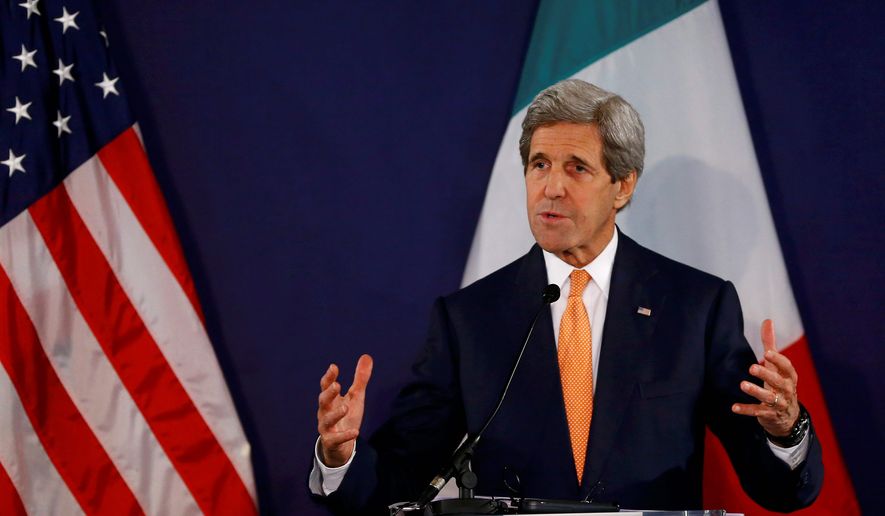President Obama last month called the failed follow-up to the Libya mission in 2011 the “worst mistake” of his presidency, but the U.S. and its allies now find themselves increasingly being drawn back into the conflict.
A small number of U.S. special operations teams have been seen on the ground in northeast and western Libya for the better part of a year, conducting patrols and advising local militias as part of the U.S.-led campaign against the Islamic State — or ISIS or ISIL — picks up steam, even as the U.S. and its European allies revealed Monday they have begun shipping weapons and equipment to Libya’s fragile unity government to battle the jihadi threat, despite U.N. sanctions.
“If you have a legitimate government and that legitimate government is fighting terrorism, that legitimate government should not be victimized” by a U.N. embargo, Secretary of State John F. Kerry told reporters in Paris after a meeting of some 20 top diplomats.
Libyan Premier Fayez al-Sarraj said his government would soon submit a weapons wish list to the Security Council for approval.
“We have a major challenge ahead of us” in fighting extremists, he said, according to The Associated Press. “We urge the international community to assist us.”
Despite the escalation, the Pentagon remains adamant U.S. troops will not be on the front lines when the campaign to oust Islamic State gets underway. The jihadi group’s outpost in Libya is its largest outside of its base in Syria and Iraq, and potentially provides significant oil revenues to fund its operations.
U.S. forces have been rotating in and out of two main bases around the northeastern coastal city of Misrata — roughly 130 miles west of the country’s capital of Tripoli — and Benghazi on the country’s western coast since last year, according to recent reports.
So far the main mission of the U.S. special operations teams in Libya has strictly been to gather information on the various armed factions fighting for control of the country and identify which ones could support U.S.-led efforts to drive Islamic State from its hub in Sirte and elsewhere.
But Monday’s decision by the U.S. and European allies to seek exemptions to a United Nations arms embargo on Libya has raised questions of whether the Obama administration was preparing to resume training militia groups in the country.
U.S. Africa Command Chief Gen. David Rodriguez has met repeatedly with members of the nascent Government of National Accord (GNA) in Tripoli to discuss where U.S. forces could provide on-the-ground support against Islamic State strongholds.
Local reports claim the American special operations teams were already training local fighters near Misrata, as well as conducting patrols in the area.
“There are some U.S. troops on the ground here, near the front line,” a Libyan militiaman based in Misrata told independent news outlet Middle East Eye. “Everyone here has seen them, but they are not fighting, they are just observing and doing patrols.”
On Monday, Pentagon spokesman Peter Cook insisted that the U.S. teams in Libya are not a precursor to a permanent American military training presence in the country, and were only there to gather intelligence.
“This is not an effort to engage in training” of local forces, he added. “That has been the goal from the start.”
Train and advise
The North African nation quickly descended into chaos shortly after secular militia groups backed by American and NATO warplanes successfully ousted Libyan strongman Moammar Gadhafi in 2011 as part of the Arab Spring movement that swept through the region.
But as the victorious armed factions involved in Gadhafi’s overthrow turned their guns on one another, battling to fill the power vacuum left in the wake of the Libyan dictator’s demise, Islamic State and other extremist groups were able to gain a sizable foothold in the country.
President Obama ordered U.S. Central Command, or CENTCOM, to begin training and arming vetted militia groups in Libya. But the Libya training program was viewed by many inside Washington as a failure, producing only 180 trained rebels at a cost of millions of dollars.
Islamic State’s presence nearly doubled in that time frame. An updated United Nations report in March put the number of Islamic State fighters in Libya at nearly 6,000, according to the Reuters news agency.
CENTCOM chief Gen. Joseph Votel told Congress in March that he plans to restart the training mission in Libya — which could involve even more U.S. troops heading into the country.
American and allied commanders have already stepped up their air operations in Libya, launching airstrikes against suspected Islamic State targets in the country. A U.S. airstrike in the eastern city of Derna in November reportedly killed Abu Nabil, the group’s top commander in Libya.
For the first time in February, the Italian government gave the Pentagon the green light to launch armed drone strikes against Islamic State targets in Libya and elsewhere in northern Africa from U.S. and NATO bases in southern Italy.
Islamic State’s ongoing exploitation of Libya’s political instability has created “the circumstances that now have caused us to act,” Defense Secretary Ashton Carter told reporters after the May 3 meeting at U.S. European Command in Stuttgart, Germany, with European allies on the Libya campaign.
Aside from the U.S. troops in Libya, there are roughly 3,500 to 5,000 U.S. military advisers and special operations forces in Iraq and Syria fighting the rising challenge from the Islamic State.
In April Mr. Obama ordered 217 U.S. troops into Iraq to back the Iraqi-led offensive to take back Mosul and 250 American special operations forces into Syria to recapture Islamic State’s stronghold in Raqqa.
• Carlo Muñoz can be reached at cmunoz@washingtontimes.com.




Please read our comment policy before commenting.